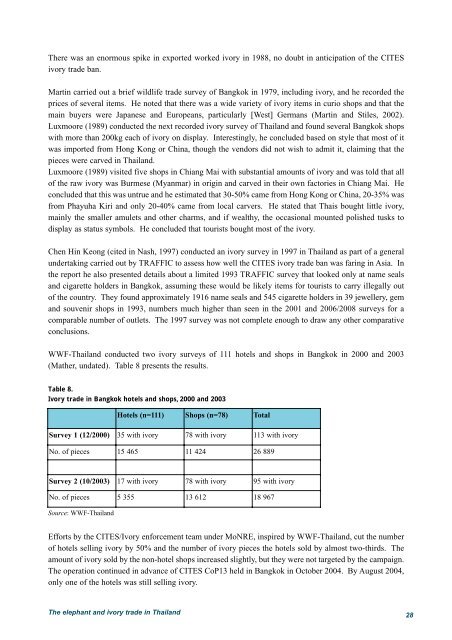The elephant and ivory trade in Thailand (PDF, 800 KB) - Traffic
The elephant and ivory trade in Thailand (PDF, 800 KB) - Traffic
The elephant and ivory trade in Thailand (PDF, 800 KB) - Traffic
Create successful ePaper yourself
Turn your PDF publications into a flip-book with our unique Google optimized e-Paper software.
<strong>The</strong>re was an enormous spike <strong>in</strong> exported worked <strong>ivory</strong> <strong>in</strong> 1988, no doubt <strong>in</strong> anticipation of the CITES<br />
<strong>ivory</strong> <strong>trade</strong> ban.<br />
Mart<strong>in</strong> carried out a brief wildlife <strong>trade</strong> survey of Bangkok <strong>in</strong> 1979, <strong>in</strong>clud<strong>in</strong>g <strong>ivory</strong>, <strong>and</strong> he recorded the<br />
prices of several items. He noted that there was a wide variety of <strong>ivory</strong> items <strong>in</strong> curio shops <strong>and</strong> that the<br />
ma<strong>in</strong> buyers were Japanese <strong>and</strong> Europeans, particularly [West] Germans (Mart<strong>in</strong> <strong>and</strong> Stiles, 2002).<br />
Luxmoore (1989) conducted the next recorded <strong>ivory</strong> survey of Thail<strong>and</strong> <strong>and</strong> found several Bangkok shops<br />
with more than 200kg each of <strong>ivory</strong> on display. Interest<strong>in</strong>gly, he concluded based on style that most of it<br />
was imported from Hong Kong or Ch<strong>in</strong>a, though the vendors did not wish to admit it, claim<strong>in</strong>g that the<br />
pieces were carved <strong>in</strong> Thail<strong>and</strong>.<br />
Luxmoore (1989) visited five shops <strong>in</strong> Chiang Mai with substantial amounts of <strong>ivory</strong> <strong>and</strong> was told that all<br />
of the raw <strong>ivory</strong> was Burmese (Myanmar) <strong>in</strong> orig<strong>in</strong> <strong>and</strong> carved <strong>in</strong> their own factories <strong>in</strong> Chiang Mai. He<br />
concluded that this was untrue <strong>and</strong> he estimated that 30-50% came from Hong Kong or Ch<strong>in</strong>a, 20-35% was<br />
from Phayuha Kiri <strong>and</strong> only 20-40% came from local carvers. He stated that Thais bought little <strong>ivory</strong>,<br />
ma<strong>in</strong>ly the smaller amulets <strong>and</strong> other charms, <strong>and</strong> if wealthy, the occasional mounted polished tusks to<br />
display as status symbols. He concluded that tourists bought most of the <strong>ivory</strong>.<br />
Chen H<strong>in</strong> Keong (cited <strong>in</strong> Nash, 1997) conducted an <strong>ivory</strong> survey <strong>in</strong> 1997 <strong>in</strong> Thail<strong>and</strong> as part of a general<br />
undertak<strong>in</strong>g carried out by TRAFFIC to assess how well the CITES <strong>ivory</strong> <strong>trade</strong> ban was far<strong>in</strong>g <strong>in</strong> Asia. In<br />
the report he also presented details about a limited 1993 TRAFFIC survey that looked only at name seals<br />
<strong>and</strong> cigarette holders <strong>in</strong> Bangkok, assum<strong>in</strong>g these would be likely items for tourists to carry illegally out<br />
of the country. <strong>The</strong>y found approximately 1916 name seals <strong>and</strong> 545 cigarette holders <strong>in</strong> 39 jewellery, gem<br />
<strong>and</strong> souvenir shops <strong>in</strong> 1993, numbers much higher than seen <strong>in</strong> the 2001 <strong>and</strong> 2006/2008 surveys for a<br />
comparable number of outlets. <strong>The</strong> 1997 survey was not complete enough to draw any other comparative<br />
conclusions.<br />
WWF-Thail<strong>and</strong> conducted two <strong>ivory</strong> surveys of 111 hotels <strong>and</strong> shops <strong>in</strong> Bangkok <strong>in</strong> 2000 <strong>and</strong> 2003<br />
(Mather, undated). Table 8 presents the results.<br />
Table 8.<br />
Ivory <strong>trade</strong> <strong>in</strong> Bangkok hotels <strong>and</strong> shops, 2000 <strong>and</strong> 2003<br />
Hotels (n=111) Shops (n=78) Total<br />
Survey 1 (12/2000) 35 with <strong>ivory</strong> 78 with <strong>ivory</strong> 113 with <strong>ivory</strong><br />
No. of pieces 15 465 11 424 26 889<br />
Survey 2 (10/2003) 17 with <strong>ivory</strong> 78 with <strong>ivory</strong> 95 with <strong>ivory</strong><br />
No. of pieces 5 355 13 612 18 967<br />
Source: WWF-Thail<strong>and</strong><br />
Efforts by the CITES/Ivory enforcement team under MoNRE, <strong>in</strong>spired by WWF-Thail<strong>and</strong>, cut the number<br />
of hotels sell<strong>in</strong>g <strong>ivory</strong> by 50% <strong>and</strong> the number of <strong>ivory</strong> pieces the hotels sold by almost two-thirds. <strong>The</strong><br />
amount of <strong>ivory</strong> sold by the non-hotel shops <strong>in</strong>creased slightly, but they were not targeted by the campaign.<br />
<strong>The</strong> operation cont<strong>in</strong>ued <strong>in</strong> advance of CITES CoP13 held <strong>in</strong> Bangkok <strong>in</strong> October 2004. By August 2004,<br />
only one of the hotels was still sell<strong>in</strong>g <strong>ivory</strong>.<br />
<strong>The</strong> <strong>elephant</strong> <strong>and</strong> <strong>ivory</strong> <strong>trade</strong> <strong>in</strong> Thail<strong>and</strong><br />
28

















